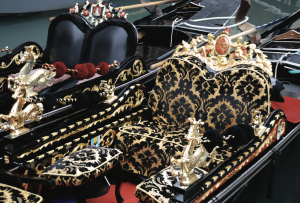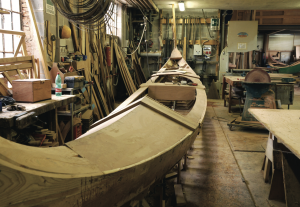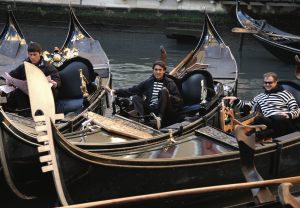Mario Matassa reveals the inside story on the gondola as he visits the workshops and discovers a tale of tradition, craftsmanship and politics…

It’s as Italian as spaghetti al pomodoro. It’s an icon of our times. It’s a 10.87m long symbol of a city, a country and a people. It’s 900 years of history and tradition. It’s la dolce vita in black lacquer, gold gilt and red velvet. It’s also the most romantically crafted vessel of our time. It’s a gondola. Try and imagine Italy without it? I can’t.
I’ve never been one for following the crowd. Having arrived to investigate the history of this iconic vessel, I find there is somewhere in the region of 100,000 people pushing their way towards Piazza San Marco. I try, as best I can, to walk in the opposite direction. The bridge is a bottleneck. A group of carnival goers in full costume are parading in front of a hundred flashing cameras (and mobile phones). I light a cigarette and wait, patiently.
A black shadow glides past in my peripheral vision. I turn in time to see the stern of the gondola glide effortlessly under the bridge. The 700kg vessel hardly causes a ripple and the crowd doesn’t even notice its passing. That’s the perfection of evolution for you. That’s what I’d come to Venice to see.
I take the vaporetto across to Redentore on the Isola della Giudecca (Island of the Giudecca). Thankfully, the crowds have thinned here, only a few late stragglers making their way hurriedly towards the vaporetto to ferry them back to the city. I dart into a backstreet and within a few short moments I am alone. The quiet and solitude is at first disconcerting, eerie even. The island feels deserted.
Master craftsmen
It takes me 15 minutes to find what I’m looking for. I hear it before I see it. It’s the distinctive sound of sand grinding on wood. Then comes the smell. It’s freshly shaved wood, tar, paint, turpentine, lacquer… I have arrived at one of the few remaining squeri (workshops) where the life of a gondola begins. The squerarioli (carpenters) are like the Mohicans: the last of a dying breed. They’ve been an autonomous corporation since 1610 and conduct their business in silence and anonymity, far removed from the glitz, buzz and fanfare that their handiwork generates.

Each and every gondola is constructed from 280 pieces of wood, eight different types in total
It’s taken them 1,000 years to perfect their trade – that’s not something one should take lightly. The gondola is a marvel of evolution and craftsmanship. First documentary evidence of it dates back to a letter written by Doge Vitale Falier in 1094, although some claim it dates as far back as 697. Each and every gondola is constructed from 280 pieces of wood, eight different types in total – fir, cherry, larch, mahogany, elm, oak, lime and walnut. The various components are assembled in precise order – although this is no flat pack! There are no left-over parts, and everything has a purpose.
In fact, nothing about the gondola has happened by chance. The design of the gondola is the product of evolution and Italian ingenuity. All are exactly 10.87m long (35ft 7in) and 1.42m wide (4ft 7in), and all have one side 24cm (10in) longer than the other. The asymmetric hull is designed to compensate for the weight of the gondolier, who steers and propels the boat from the rear. This imbalance gives the gondola its distinctive tilt.

The gondola has undergone a process of subtle change and improvement over the centuries to the extent that today’s version would be hardly be recognisable from its originator. The earliest form had 12 oars. Today, of course, they have just one, making the gondola the only boat in the world that weighs over 600kg that can be propelled by just one person. Nor were they always black. In 1562 the boats had become so ornate that the Doge of Venice decreed that all gondolas were to be painted a uniform colour – black – and that exterior decoration was to be restricted to the distinctive prow iron or ferro (which counterbalances the weight of the gondolier), a curly tail and a pair of seahorses.
In a waterside workshop near San Rocco on the western side of the Grand Canal, Pietro, an apprentice remeri (specialist craftsman) is explaining the stages in the production of the forcola (the boat’s distinctive elbow-like row lock). Without the forcola, there is no oar, no navigation, no boat. It’s the central hub upon which everything else falls into place. Each forcola is sculpted from a single piece of walnut aged up to three years.
“It’s not just functional,” Pietro explains. “It has to be beautiful.” The forcola, a work of sculptured art, has become a symbol of the city. It is made to order. They say the gondolier can sell his boat, but never his forcola – they keep them forever, passing it down from one generation to the next. Traditions are sacred; nothing is more important.
For more on Venice, see our archive
